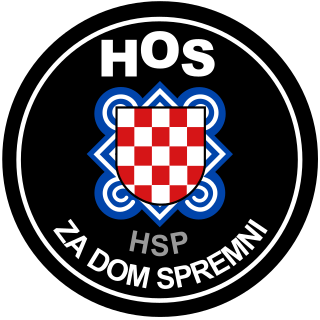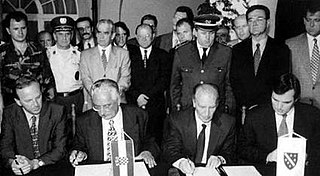
The Bosnian War was an international armed conflict that took place in Bosnia and Herzegovina between 1992 and 1995. The war is commonly seen as having started on 6 April 1992, following a number of earlier violent incidents. The war ended on 14 December 1995 when the Dayton accords were signed. The main belligerents were the forces of the Republic of Bosnia and Herzegovina, the Republic of Herzeg-Bosnia, and the Republika Srpska, the latter two entities being proto-states led and supplied by Croatia and Serbia, respectively.
Gojko Šušak was a Croatian politician who held the post of Minister of Defence from 1991 to 1998 under President Franjo Tuđman. From 1990 to 1991 he was the Minister of Emigration and in 1991 the Deputy Minister of Defence.

Mate Boban was a Bosnian Croat politician and one of the founders of the Croatian Republic of Herzeg-Bosnia, an unrecognized entity within Bosnia and Herzegovina. He was the first president of Herzeg-Bosnia from 1991 until 1994. From 1992 to 1994, Boban was the President of the Croatian Democratic Union. He died in 1997 due to a stroke.

The Croatian Defence Forces were the paramilitary arm of the Croatian Party of Rights (HSP) from 1991 to 1992, during the first stages of the Yugoslav wars. During the Croatian War of Independence, the HOS organised several early companies and participated in Croatia's defence. At the peak of the war in Croatia, the HOS was several battalions in size. The first HOS units were headed by Ante Paradžik, a HSP member who was killed by Croatian police in September 1991. After the November 1991 general mobilisation in Croatia and the January 1992 cease-fire, the HOS was absorbed by the Croatian Army.

Kupres is a town and the seat of the Municipality of Kupres in Canton 10 of the Federation of Bosnia and Herzegovina, an entity of Bosnia and Herzegovina. As of 2013, it has a population of 5,057 inhabitants, while the town of Kupres has a population of 2,883 inhabitants.

The Croatian Republic of Herzeg-Bosnia was an unrecognized geopolitical entity and quasi-state in Bosnia and Herzegovina. It was proclaimed on 18 November 1991 under the name Croatian Community of Herzeg-Bosnia as a "political, cultural, economic and territorial whole" in the territory of Bosnia and Herzegovina, and abolished on 14 August 1996.

Operation Summer '95 was a joint military offensive of the Croatian Army (HV) and the Croatian Defence Council (HVO) that took place north-west of the Livanjsko Polje, and around Bosansko Grahovo and Glamoč in western Bosnia and Herzegovina. The operation was carried out between 25 and 29 July 1995, during the Croatian War of Independence and the Bosnian War. The attacking force of 8,500 troops commanded by HV's Lieutenant General Ante Gotovina initially encountered strong resistance from the 5,500-strong Army of Republika Srpska (VRS) 2nd Krajina Corps. The HV/HVO pushed the VRS back, capturing about 1,600 square kilometres of territory and consequently intercepting the Knin—Drvar road—a critical supply route of the self-declared Republic of Serbian Krajina (RSK). The operation failed to achieve its declared primary goal of drawing VRS units away from the besieged city of Bihać, but it placed the HV in position to capture the RSK's capital Knin in Operation Storm days later.

The Croat–Bosniak War was a conflict between the Republic of Bosnia and Herzegovina and the Republic of Herzeg-Bosnia, supported by Croatia, that lasted from 18 October 1992 to 23 February 1994. It is often referred to as a "war within a war" because it was part of the larger Bosnian War. In the beginning, the Army of the Republic of Bosnia and Herzegovina and the Croatian Defence Council (HVO) fought together in an alliance against the Yugoslav People's Army (JNA) and the Army of Republika Srpska (VRS). By the end of 1992, however, tensions between Bosniaks and Bosnian Croats increased. The first armed incidents between them occurred in October 1992 in central Bosnia. The military alliance continued until early 1993, when it mostly fell apart and the two former allies engaged in open conflict.
Operation Corridor 92 was the largest operation conducted during the Bosnian War by the Army of Republika Srpska (VRS) against the forces of the Croatian Defence Council (HVO) and the Croatian Army (HV) in the Bosanska Posavina region of northern Bosnia and Herzegovina between 24 June and 6 October 1992. The objective of the offensive was to re-establish a road link between the city of Banja Luka in the west of the country and the eastern parts of the territory controlled by the Bosnian Serbs. The offensive was prompted by the capture of Derventa by the HV and the HVO – a move that blocked the single overland road between the VRS-controlled territories.
Operation Vrbas '92 was a military offensive undertaken by the Army of Republika Srpska in June–October 1992, during the Bosnian War. The goal of the operation was the destruction of a salient around the central Bosnian town of Jajce, which was held by the Croatian Defence Council and the Army of the Republic of Bosnia and Herzegovina. The intensity of fighting varied considerably and involved several major VRS offensive efforts interspersed by relative lulls in fighting. Jajce fell to the VRS on 29 October 1992, and the town's capture was followed by the destruction of all its mosques and Roman Catholic churches.
Operation Winter '94 was a joint military offensive of the Croatian Army (HV) and the Croatian Defence Council (HVO) fought in southwestern Bosnia and Herzegovina between 29 November and 24 December 1994. The operation formed part of the Croatian War of Independence and the Bosnian War fought between Bosnia and Herzegovina, Croatia and two unrecognized para-states proclaimed by Croatian Serbs and Bosnian Serbs. Both para-states were supported by the Yugoslav People's Army (JNA) and Serbia. The JNA pulled out in 1992, but transferred much of its equipment to the Bosnian Serb and Croatian Serb forces as it withdrew.

The Croat–Bosniak War was a conflict between the Republic of Bosnia and Herzegovina and the Croatian Community of Herzeg-Bosnia, supported by Croatia, that lasted from 19 June 1992 – 23 February 1994. The Croat-Bosniak War is often referred to as a "war within a war" because it was part of the larger Bosnian War.
Čelebić is a village in the City of Livno in Canton 10 of the Federation of Bosnia and Herzegovina, an entity of Bosnia and Herzegovina. During the Bosnian War the village was divided between the Serb and the Croat forces until December 1994, when the Croats took control of the village.

The Siege of Mostar was fought during the Bosnian War first in 1992 and then again later in 1993 to 1994. Initially lasting between April 1992 and June 1992, it involved the Croatian Defence Council (HVO) and the Army of the Republic of Bosnia and Herzegovina (ARBiH) fighting against the Serb-dominated Yugoslav People's Army (JNA) after Bosnia and Herzegovina declared its independence from Yugoslavia. That phase ended in June 1992 after the success of Operation Jackal, launched by the Croatian Army (HV) and HVO. As a result of the first siege around 90,000 residents of Mostar fled and numerous religious buildings, cultural institutions, and bridges were damaged or destroyed.

The Split Agreement or Split Declaration was a mutual defence agreement between Croatia, the Republic of Bosnia and Herzegovina and the Federation of Bosnia and Herzegovina, signed in Split, Croatia on 22 July 1995. It called on the Croatian Army (HV) to intervene militarily in Bosnia and Herzegovina, primarily in relieving the siege of Bihać.

The Battle of Kupres was a battle of the Bosnian War, fought between the Army of the Republic of Bosnia and Herzegovina (ARBiH) and the Croatian Defence Council (HVO) on one side and the Army of Republika Srpska (VRS) on the other from 20 October to 3 November 1994. It marks the first tangible evidence of the Bosniak–Croat alliance set out in the Washington Agreement of March 1994, brokered by the United States to end the Croat–Bosniak War fought between the ARBiH and the HVO in Bosnia and Herzegovina. The ARBiH and the HVO were not coordinated at first, rather they launched separate operations aimed at capture of Kupres.
The Agreement on Friendship and Cooperation between Bosnia and Herzegovina and Croatia was signed by Alija Izetbegović, President of the Republic of Bosnia and Herzegovina, and Franjo Tuđman, President of the Republic of Croatia, in Zagreb on 21 July 1992 during the Bosnian and Croatian wars for independence from Yugoslavia. It established cooperation, albeit inharmonious, between the two and served as a basis for joint defense against Serb forces. It also placed the Croatian Defence Council (HVO) under the command of the Army of the Republic of Bosnia and Herzegovina (ARBiH).
The Battle of Kupres was a battle of the Bosnian War, fought between the Bosnian Croat Territorial Defence Force supported by the Croatian Army troops on one side and the Yugoslav People's Army, augmented by the Bosnian Serb TO on the other at the Kupres Plateau, on 3–11 April 1992. During the fighting on 8 April, the Bosnian Croat TO was reorganised as the Croatian Defence Council. The objective of the battle was to control the strategic Kupres Plateau, a major supply route.
Operation Una was a military offensive conducted by the Croatian Army against the Army of Republika Srpska in western Bosnia and Herzegovina on 18–19 September 1995, during the Bosnian War. The operation entailed a crossing of the Una and Sava rivers to establish bridgeheads at Novi Grad, Bosanska Dubica, Bosanska Kostajnica and opposite Jasenovac to allow for a subsequent advance towards Prijedor and Banja Luka.
The Battle of Bugojno was fought between forces of the Army of the Republic of Bosnia and Herzegovina (ARBiH) and the Croatian Defence Council (HVO) for control of the town and municipality of Bugojno in central Bosnia, from 18–28 July 1993. The area of Bugojno was under joint control of the ARBiH 307th Brigade and the HVO Eugen Kvaternik Brigade since the start of the Bosnian War. Violent incidents in Bugojno followed the escalation of the Croat-Bosniak War in adjacent municipalities throughout the 1st half of 1993. Bugojno was spared from fighting and the two local brigades were still formally allied by June 1993, at the time of an ARBiH offensive in central Bosnia.










